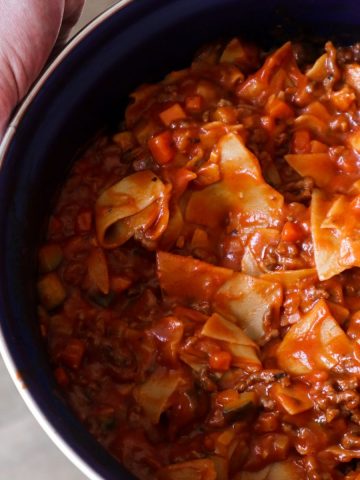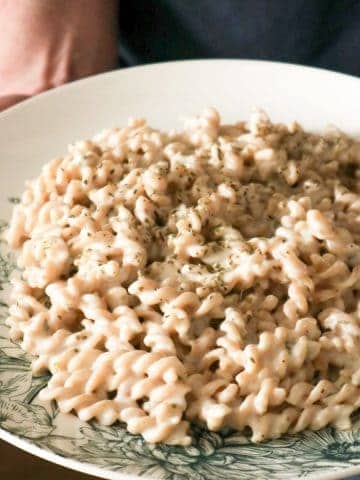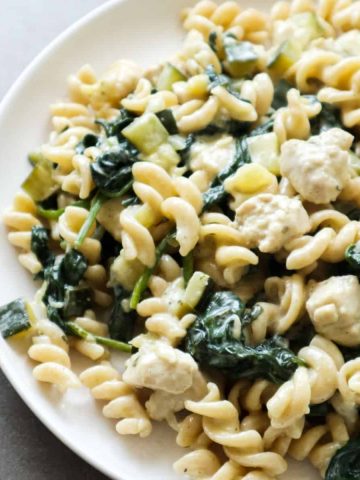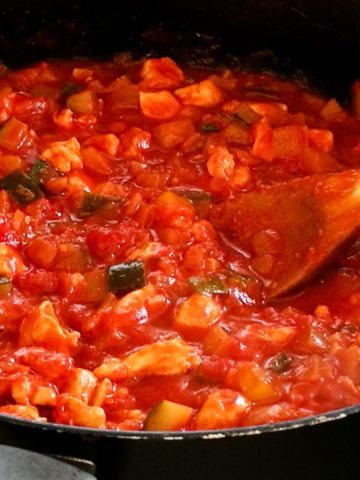Making homemade pasta is easier than you think, and fresh pasta tastes so much better than store-bought. All you need for pasta dough is flour, eggs, and salt.

Fresh homemade pasta is fantastic with a simple sauce like marinara sauce or my recipe for spaghetti sauce, but you can also use it for a pasta salad, red pesto pasta, and pasta Boursin.
Fresh vs dried pasta
Okay, let's be honest dried pasta is a lot easier than making your own. After all, you need nothing more than a pan of boiling water and possibly a colander to drain.
But dried pasta doesn't have the velvety texture and full flavor that fresh pasta does.
Ingredients
Flour - many recipes call for durum flour, but it is not necessarily necessary. Regular all-purpose flour also works just as well well for this recipe.
Eggs - eggs provide the full flavor and soft texture. They also keep your dough from drying out and losing its shape while cooking.
Salt - salt provides flavor. So add a little to the dough AND the cooking water.
Olive oil - to prevent your homemade pasta dough from becoming too dry, you can add a little olive oil. This is not always necessary, so try what you like best yourself.
You can find the complete ingredient list and instructions on the recipe card below!

Instructions
On a clean countertop, make a mound of flour and make a well. Put in the eggs and salt, and from the center, carefully stir more and more flour into the eggs.
When most of the flour is mixed in, knead the dough with your hands for about 10 minutes until you have a firm pasta dough that springs back when you press it gently.
It is normal if this is a little difficult at first and the dough seems too dry. It will get better.
When your dough is kneaded enough, wrap it in plastic wrap and let it rest at room temperature for 30-60 minutes before proceeding.
Processing the dough is easiest if you divide it into smaller pieces. Store the pasta dough you don't use in plastic wrap or under a clean tea towel.
With a pasta machine
Divide the dough into four pieces and roll out one piece, so it goes through the pasta machine easier. Set the machine to the largest setting and run it about three times dough through the machine.
To keep your dough from sticking to the machine, it's wise to sprinkle a little flour on your dough each time.
Repeat the previous step on an increasingly smaller setting until your dough is the desired thickness. Process the remaining dough in the same way or freeze it for later use.
Making pasta without a machine
Not everyone owns a pasta machine. That does not matter. Even with a rolling pin, you can make delicious pasta.
Divide the dough into 4-6 pieces and roll out each piece until it has the desired thickness. Turn the dough occasionally to prevent it from sticking to your countertop.
Shaping the pasta
After making your dough, cut or shape it into your desired type of pasta. The easiest way is to make your own tagliatelle.
Sprinkle some flour over the rolled-out dough and fold it a few times. Cut half-inch strips from it with a sharp knife and shake off the excess flour.
Keep it on a rack as you process the rest of the dough to prevent it from sticking together.
Cooking fresh pasta
For every 100 grams of pasta, put about 4 cups or 1 liter of water. You don't need to cook fresh pasta as long as dried pasta so it will be ready in no time.
In a large pot, bring the water to a boil and add salt. Don't add the same immediately because it will take longer to reach boiling temperature.
Add the pasta to the boiling water and let it cook for about two minutes before draining.
If you have let the pasta dry for a while before using it, the cooking time may be a minute longer.

When to use which shape
The dough is often the same, but sometimes a different shape suits a dish just a little better. Textured pasta like fusilli, for example, holds the sauce better, and smooth types like lasagna and cannelloni are more suitable for filling and stacking.
In addition, you have all-purpose pasta like spaghetti and tagliatelle that are always good, especially with a classic sauce like carbonara.
Dough made with egg is a bit firmer and, therefore, very suitable for making stuffed pasta like ravioli and tortellini.
My tips for making fresh pasta
- Take your time. Especially if you've never made fresh pasta before, it's best not to rush it.
- Also, try a different type of flour. Besides just being fun to experiment with, each type of grain gives a different taste and texture to your dough. For example, try real durum or spelt to make the dough.
Equipment
A scale to weigh out the flour.
- It is best to use a pasta machine, but a rolling pin will also work. If you're making a long pasta like tagliatelle, it's also a good idea to have a special rack handy.
Storage
You can store homemade pasta in the refrigerator for about 1-2 days. If you want to keep it longer, I recommend freezing it.
Divide the pasta into freezer bags or containers before you put it in the freezer. This way, you can store it for about six months.
If you have some dough left over, you can also keep that in the freezer. Form it into balls and wrap them in plastic wrap.
Let the dough thaw slowly in the refrigerator before use, and knead it for a while before further processing.
You can also let fresh pasta dry so you can store it at room temperature.
Toss the pasta in some flour to prevent it from sticking together. Place it on a baking sheet and make sure there are no pieces pressing against each other or hang longer pasta on a special drying rack.
Put the pasta in a dry place but out of direct sunlight and let it stand until completely dry. This usually takes about a day.
More pasta recipes you will love

How to make pasta from scratch
Instructions
- On a clean countertop, make a mound of the flour and make a well. Put in the eggs and salt; from the center, carefully stir more and more flour into the eggs.
- When most of the flour is mixed in, knead the dough with your hands for about 10 minutes until you have a firm pasta dough that springs back when you press it gently.
- It is normal if this is a little difficult at first and the dough seems too dry. It will get better. When your dough is kneaded enough, wrap it in plastic wrap and let it rest at room temperature for 30-60 minutes before proceeding.
- Processing the dough is easiest if you divide it into smaller pieces. Store the pasta dough you don't use in plastic wrap or under a clean tea towel.
With a pasta machine
- Divide the dough into four pieces and roll out one piece, so it goes through the pasta machine easier. Set the machine to the largest setting and run it about three times dough through the machine.
- To keep your dough from sticking to the machine, it's wise to sprinkle a little flour on your dough each time.
- Repeat the previous step on an increasingly smaller setting until your dough is the desired thickness. Process the remaining dough in the same way or freeze it for later use.
Making pasta without a machine
- Not everyone owns a pasta machine. That does not matter. Even with a rolling pin, you can make delicious pasta.
- Divide the dough into 4-6 pieces and roll out each piece until it has the desired thickness. Turn the dough occasionally to prevent it from sticking to your countertop.
Shaping the pasta
- After making your dough, cut or shape it into your desired type of pasta. The easiest way is to make your own tagliatelle.
- Sprinkle some flour over the rolled-out dough and fold it a few times. Cut half-inch strips from it with a sharp knife and shake off the excess flour.
- Keep it on a rack as you process the rest of the dough to prevent it from sticking together.
Cooking fresh pasta
- For every 100 grams of pasta, put about 4 cups or 1 liter of water. You don't need to cook fresh pasta as long as dried pasta so it will be ready in no time.
- Bring the water to a boil in a large pot and add salt. Don't add the same immediately because it will take longer to reach boiling temperature.
- Add the pasta to the boiling water and let it cook for about two minutes before draining.
- If you have let the pasta dry for a while before using it, the cooking time may be a minute longer.







Leave a Reply